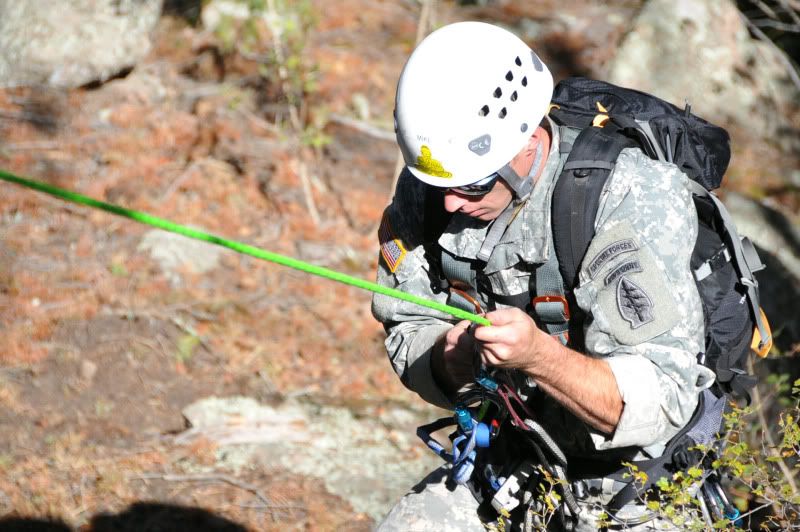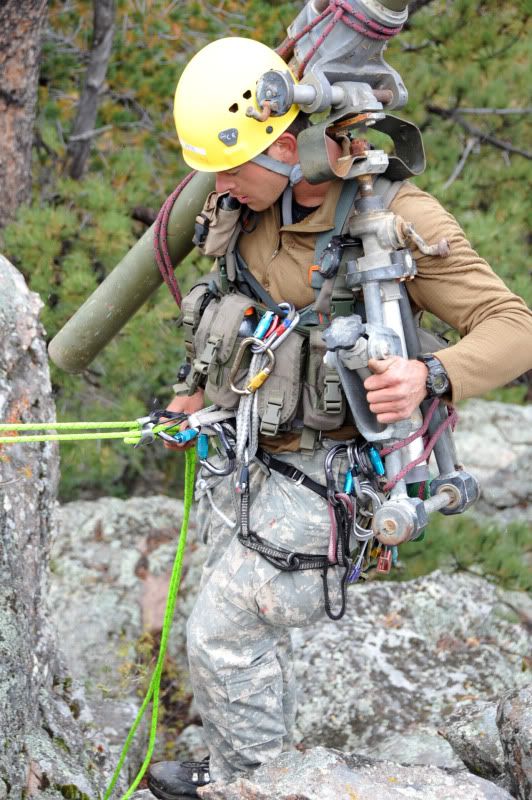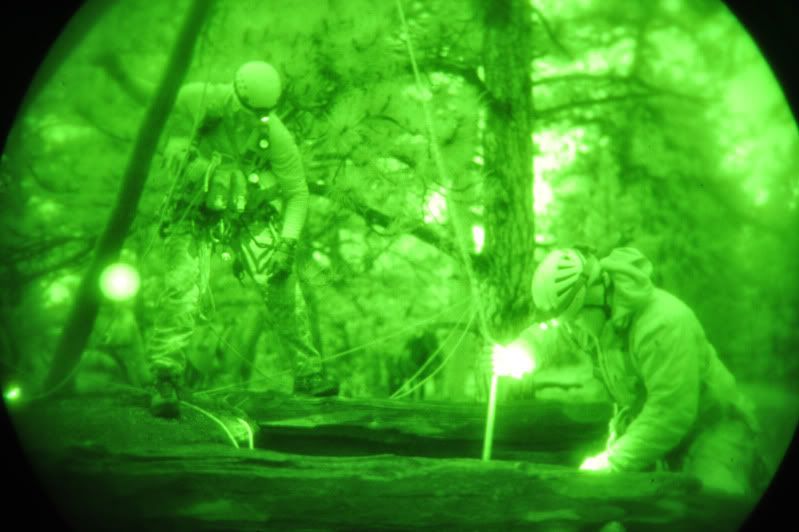 Hires
Hires
10th SFG (A) conducts USASFC Mountaineer ProgramCHUGACH MOUNTAINS, Alaska -- A 10th Special Forces Group (Airborne) mountaineer climbs out of Worthington Glacier during the U.S. Army Special Forces Command (Airborne) Master Mountaineer Course. (U.S. Army photo by Chief Warrant Officer Dennis Oglesby)
By Staff Sgt. Michael R. Noggle
10th SFG (A) Public Affairs NCOIC
FORT CARSON, Colo. – Special Forces Soldiers train to operate in the worst possible conditions, and for the Green Berets of the 10th Special Forces Group (Airborne) that just happens to mean some of the coldest temperatures imaginable.
In the Fall of 1996, the U.S. Army Special Forces Command (Airborne) tasked Soldiers of the 10th SFG (A) to conduct the ten-week SF Mountaineering Program. Since then, 317 SF Soldiers, Rangers, Navy Special Warfare and Marines have graduated the Master Course, which includes a 25 percent drop-out rate.
To accommodate the high operational tempo in today’s Global War on Terrorism, the USASFC (A) Mountain Detachment divided the program into three levels, all allowing Special Operations servicemembers to attend while maintaining the same standards.
“The courses initially were run every other year and were roughly two and a half months in length,” said Chief Warrant Officer Dennis P. Oglesby, Combat Environmental Detachment commander. “Master Sgt. Troy Campbell [Combat Environmental Detachment NCOIC] and I talked about two different, shorter courses at five weeks apiece.”
The Basic Course (Level III) is taught at the Operational Detachment-Alpha level by graduates of the USASFC (A) Mountain Course. A team member learns 15 basic tasks, including navigating in mountainous terrain, rope commands, transportation of a casualty on an improvised litter and rappelling techniques.
After which, they are sent to Fort Carson to attend the Senior Course (Level II) where they are expected to know and pass a hands-on test on the basic fundamentals of rock climbing
“The reason we teach the Senior Course (Level II) is everything needs to be finite,” said Oglesby. “All rescue systems, how you conduct yourself on the rock, planning mountaineering operations. There has to be one particular way you do it.”
Throughout the Senior course, students go to rigorous heights and drastic measures as they take on the alpine portion of the Mountaineer course. Among the 17 tasks in the Senior Course (Level II), they must be proficient at constructing a belay point, rappelling point and setting up rescue systems should they need to assist a stranded climber.
“We’re teaching these guys not only how to rock climb, but guiding techniques and (how) to be competent at rescue techniques,” Oglesby said. “Everything that a guy brings with him to the rock that day will also convert to a rescue package if he needs to get someone off the rock.”
The Master Course (Level I) is the winter alpine stage of the mountaineering program and begins similar to Senior Course. Students must complete the hands-on test which is a review from previous tasks.
Previous Master Courses have started in Colorado and finished in Alaska. The final 12 tasks familiarize the class with glacier movement, avalanche awareness, ice climbing, bivouac considerations and crevasse rescue.
“When a Senior or Master Course graduate goes back to his unit, he is the subject-matter expert for that unit on all mountaineering operations,” Oglesby said. “He is responsible for reviewing all mountaineering training schedules, memorandum of instruction, and risk assessment for training and operations.”
Oglesby said he envisions one Mountaineer Detachment in every SF Company throughout USASFC (A).
“We want to make more graduates without changing any of the standards and try to make this program grow as much as possible,” Oglesby said. “It’s a hard task ahead but it’s an achievable goal with the support we are getting from USASFC (A).”
 (Click for Hires)
(Click for Hires)
VAIL PASS, Colo. -- A team of Marines and 10th Special Forces Group (Airborne) Soldiers conduct cold weather training at Vail Pass in the Rocky Mountains, Feb. 22. (U.S. Army photo by Staff Sgt. Michael R. Noggle)
 (Click for Hires)
(Click for Hires)
A member from the Special Forces Mountain Detachment, 10th SF Group (Airborne), Fort Carson, Colo., conducts Mountaineer and Rescue Training in the Rocky Mountains, Feb. 5. (U.S. Army photo by Staff Sgt. Michael R. Noggle)
 (Click for Hires)
(Click for Hires) (Click for Hires)
(Click for Hires)
MOSQUITO MOUNTAIN RANGE, Colo. -- 10th Special Forces Group (Airborne) Mountaineers navigate up Horseshoe Mountain during a training exercise last year. (U.S. Army photo by Chief Warrant Officer 4 Dennis Oglesby




